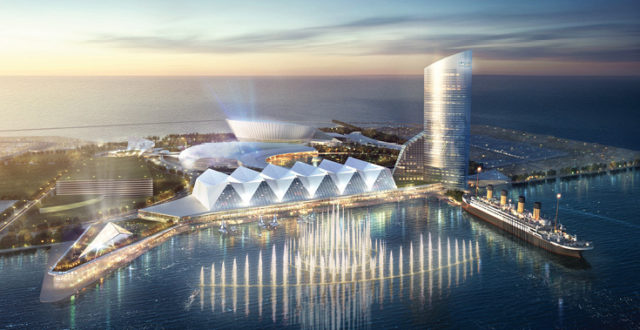by Dale Watanabe, For the North American Post
Casino gambling in Japan? There will be three locations in Japan that will be allowed to have casinos as part of an “Integrated Resort.” The legislation was passed in July 2018 and the selection process is being determined now to have locations chosen and resorts open by 2024 or 2025 according to Dr. Toru Mihara, who was a featured speaker at Japan-America Society of the State of Washington’s Japan Update event held on February 26, 2019 at Bellevue City Hall.

Mihara, who served on the eight person committee appointed by Prime Minister Abe, is the Director of the Institute for Amusement Industry Study at the Osaka University of Commerce and Chairman of the National Council on Gaming Legislation. The legislation passed in July with a total of 251 articles, 16 additional clauses and 331 items for Ministerial Decrees is “the biggest law made in the past 21 years.”
Integrated Resorts or IR, as defined in the law, consists of two categories of facilities, constructed and operated by a single private entity They are core facilities and casino. Obligatory core facilities include a convention facility, exhibit & trade fair facility, tourism attraction, tourism promotion, and hotel. Casino facilities cannot exceed three percent of the entire IR floor space. Mihara clarified that tourism attractions such as a golf course can only count the square footage under a roof as part of the IR for the casino calculation. He pointed out that existing convention facilities in Japan are too small compared to those of other countries.
The law requires that the IR investor/operator funds, constructs and operates the world class MICE and hotel as mandatory non-gaming facilities. Mihara presented concept drawings for Yokohama by Caesars’ and Osaka by MGM and by Melco. Candidate locations include Tomakomai City in Hokkaido, locations in and around Tokyo, as well as outlying areas from Miyagi Aichi, Wakayama, Mie and Nagasaki prefectures. Seemingly the most active and public has been Osaka in a bid to be one of the three locations.
Anticipated private investments are expected to exceed 600 billion yen and may be as much as 1 trillion yen. Regional revitalization with tourism promotion is an important State policy as one of the measures for regional revitalization during an era of aging population and decreasing birth rate. Mihara pointed out that IR may be the best chance to increase Japan’s attractiveness abroad, as well as domestically, through these new, unique landmark facilities and services.
Emergence of new hospitality business is expected to have extended economic ripple effects. New business opportunities range from constructon and development, food and beverage, travel, luxury shopping as well as live entertainment, transportation, and many other services. Tourism, travel and entertainment are labor intensive industries which drive high employment power for these locations.
How does IR affect the U.S.-Japan relationship? Mihara pointed out that no Japanese enterprises exist that have expertise, experience and know-how on managing and operating casinos. Major operators in the market are mostly American firms. Casino regulations passed in Japan are similar to U.S. practices, hence entry into business could be easy for U.S. firms. That said, he believes there is high probability that U.S.-Japan alliance may be the best potential investor/operator. Privately, Mihara pointed out that U.S. technology being used now in the U.S. is old, but ubiquitous which makes it hard to change. With IR, opportunities for Japanese firms are significant with their state of the art technology for machines, systems for control, surveillance and protection against forgery that can set a new high standard.
Mihara pointed out IR may change Japan in a number of ways. This challenge to live with Japanese tradition and culture with a whole new industry will be a test and an opportunity in Japan.







